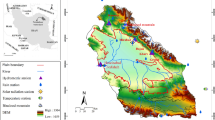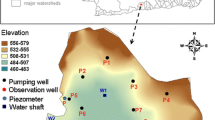Abstract
Change in groundwater dynamics (in terms of changes in depth to watertable and its salinity) is a key environmental concern for agricultural production using pulp and paper mill effluent for irrigation purposes. At the study site, the treated effluent is delivered from the mill into a winter storage dam. This storage dam is also meant to provide an opportunity for runoff collection and recycling for irrigated areas. A natural creek also exists along the farm boundary. This paper presents, using field observation data and computer simulation results, the impact of using treated effluent from the pulp and paper mill on groundwater dynamics at the farm (covering areas both under and outside the effluent irrigation paddocks); and on the flows in the adjacent creek. The modeling results show that after 5 years of operations, the change in aquifer storage is more under average climatic conditions (−23.5 mm/year) as compared to −7.1 and −9.0 mm/year under dry and wet climatic conditions, .respectively. Under average climatic conditions, the combined effect of irrigation and rainfall creates more hydraulic gradient towards the creek thereby depleting the aquifer storage more as compared to wet and dry climatic conditions. Resultantly, the subsurface groundwater flows towards the creek becomes around 57.9 mm/year under average scenario as compared to 55.0 and 36.7 mm/year under wet and dry climatic conditions, respectively. During the average climatic condition, 456.6 mm evaporation from shallow groundwater was estimated under the current management practices; which was reduced to 399.1 mm under the best management practices due to better use of all sources of water and capillary upflow from shallow groundwater. Thus, with the adoption of best management practices, there would be less risk of salinisation due to evaporation from shallow groundwater tables.










Similar content being viewed by others
Notes
According to the Australian Soil Classification (Isbell 1996), soil horizon is a specific layer in the soil which parallels the land surface and possesses physical characteristics which differ from the layers above and beneath. Among the several other main horizons, A horizon is a surface horizon, and as such is also known as the zone in which most biological activity occurs. It is usually subdivided into several sub-horizons. The A1 is dark colored and high in content of organic matter; the A2 is usually light colored and leached; the A3 is transitional to the B horizon.
References
Al-Jamal, M. S., Sammis, T. W., Mexal, J. G., Picchioni, G. A., & Zachritz, W. H. (2002). A growth-irrigation scheduling model for wastewater use in forest production. Agricultural Water Management, 56, 57–79.
Allen, R. G., Pereira, L. S., Raes, D., & Smith, M. (1998). Crop evapotranspiration: Guidelines for computing crop water requirements. FAO Irrigation and Drainage Paper 56. Rome: Food and Agriculture Organization of the United Nations.
ANZECC (2000). Australian and New Zealand guidelines for fresh and marine waters. National Water Quality Management Strategy Paper No 4. Australian and New Zealand Environment and Conservation Council (ANZECC), and Agriculture and Resource Management Council of Australia and New Zealand (ARMCANZ), Canberra.
Bond, W. J. (1998). Effluent irrigation – An environmental challenge for soil science. Australian Journal of Soil Research, 36, 543–555.
Chiang, W. H., & Kinzelbach, W. (1998). Processing MODFLOW: A simulation system for modeling groundwater flow and pollution: Software manual, 325p.
DEC (2004). Use of effluent by irrigation. Environmental guidelines. Australia, NSW: Department of Environment and Conservation (DEC).
Dominguez-Mariani, E., Carrillo-Chavez, A., Ortega, A., & Orozco-Esquivel, M. T. (2003). Wastewater reuse in Valsequillo Agricultural Area, Mexico: Environmental impact on groundwater. Water, Air and Soil Pollution, 155, 251–267.
EPR (1988). General standards for discharge of effluents: Schedule II, Rule 3, The Environmental (Protection) Rules. GSR 919(E) published in the Government of India Gazette 488, 12 September 1988.
Fazeli, M. S., Khosravan, F., Hossini, M., Sathyanarayan, S., & Satish, P. N. (1998). Enrichment of heavy metals in paddy crops irrigated by paper mill effluent near near Nanjangud, Mysore District, Karnataka, India. Environmental Geology, 34, 297–302.
Fazeli, M. S., Sathyanarayan, S., Satish, P. N., & Muthanna, L. (1991). Effect of paper mill effluents on accumulation of heavy metals in coconut tress near Nanjangud, Mysore District, Karnataka, India. Environmental Geology, 17, 47–50.
Hess, T., & Counsell, C. J. (2000). Aids to improved agricultural drainage – WaSim Technical Manual, Version 1.4. HR Wallingford Report.
Isbell, R. F. (1996). The Australian soil classification. Australia, Collingwood: CSIRO.
Juwarkar, A. S., & Subrahmanyam, P. V. R. (1987). Impact of pulp and paper mill wastewater on crop and soil. Water Science and Technology, 19, 693–700.
Kannan, K., & Oblisami, G. (1990). Influence of irrigation with pulp and paper mill effluent on soil chemical and microbiological properties. Biology and Fertility of Soils, 10, 197–201.
Lewis, B. (2002). Farm dams: Planning, construction and maintenance, 152p. Landlinks Press, CSIRO Publishing.
McDonald, M. G., & Harbaugh, A. W. (1988). MODFLOW: A modular three-dimensional finite-difference ground-water flow model. Technical report, Reston, VA: US Geol. Survey.
Norris, P. J. (1998). Water reclamation operations in a zero effluent mill. In Proceedings of the 1998 environmental conference (vol. 3, pp. 1045–1050). Norcross, GA: TAPPI Press.
Phukan, S., & Bhattacharyya, K. G. (2003). Modification of soil quality near a pulp and paper mill. Water, Air, and Soil Pollution, 146, 319–333.
Robertson, L. R., & Schwingel, W. R. (1997). Effect of water reuse on paper machine microbiology. In Proceedings of the 1997 environmental conference (vol. 1, pp. 87–93). Norcross, GA: TAPPI Press.
Szolosi, O. (2003). Water cycle with zero discharge at Visy pulp and paper, Tumut, NSW. Water (Australia), 30, 34–36.
Thompson, G., Swain, J., Kay, M., & Forster, C. F. (2001). The treatment of pulp and paper mill effluent: A review. Bioresource Technology, 77, 275–286.
WHO (1989). Health guidelines for the use of wastewater in agriculture and aquaculture. Report of a World Health Organization Scientific Group, Technical Report Series 778, Geneva, Switzerland.
Wiseman, N., & Ogden, G. (1996). Zero liquid effluent technologies for the paper industries. Paper Technology, 37, 31–38.
Zheng, C. (1990). MT3D: A modular three-dimensional transport model for simulation of advection, dispersion and chemical reactions of contaminants in groundwater systems. Report to the US Environmental Protection Agency, 170p.
Author information
Authors and Affiliations
Corresponding author
Rights and permissions
About this article
Cite this article
Khan, S., Asghar, M.N. & Rana, T. Characterizing Groundwater Dynamics Based on Impact of Pulp and Paper Mill Effluent Irrigation and Climate Variability. Water Air Soil Pollut 185, 131–148 (2007). https://doi.org/10.1007/s11270-007-9437-6
Received:
Accepted:
Published:
Issue Date:
DOI: https://doi.org/10.1007/s11270-007-9437-6




